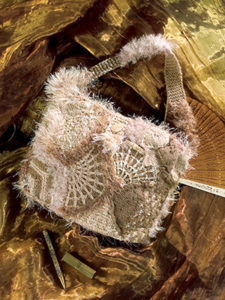Free-form knitting means no rules, usually no instructions and no right or wrong way. Sound interesting? Keep on reading!
What exactly does free-form knitting mean? The term “free-form” is usually given to a type of fabric created by using many different yarns in a multi-stitch, multidirectional manner. This fabric can be used to create wearable garments, bags, hats, pillows, wall hangings, etc. There are as many different approaches to the method as there are artists creating it.
Here is one “rule” that I generally follow while free-form knitting: Use the most intricate stitches, like two-tone lattice, with the plainest of yarns, and the simplest stitches, like garter stitch, with the highly textured, fuzzy yarns.
You will note that I said there are “usually no instructions.” Many free-form knitting artists believe that trying to write instructions for free-form defeats the whole purpose. It is, after all, supposed to be “free.” After quite a few years of teaching workshops in conventional and free-form knitting styles, it is clear that beginners appreciate a little instruction to get them started. It is my hope that by providing some instruction, soon their own creativity will be sparked. After completing a single project, and sometimes even before completion, imagination starts to take over, and students take off. The other interesting thing is that, when a dozen students are given the same set of written free-form knitting instructions, twelve very different pieces emerge. The reasons for this phenomenon are yarn choices, interpretation of the instructions, and most important of all, individual imagination.
Once you have decided what you would like to make, choose a color combination. If you feel that you are not very good at choosing colors, one foolproof method is to choose a multicolored yarn, then pull solids to match from the colors. Begin experimenting with some small pieces of knit, using several yarns and stitches in the same piece. Adding some of the lovely designer yarns makes a piece really special. Dye lot is not a problem when working free-form knitting. You can add new yarns as you go along.
Lining Method
For the lining method, you will need a suitable fabric to which you can sew your pieces. Polar fleece, muslin, or an ordinary sweatshirt may be used for lining. You can use a commercial pattern or you can make your own by tracing an existing garment. The lining will become a permanent part of your garment.
After you have some pieces made, begin pinning them onto your lining, and when you have an arrangement that you love, sew the pieces right to the lining and to each other. Do not start sewing till you are sure of your placement. Then sew the pieces on with small firm stitches.
Template Method
The template method of free-form knitting is worked similarly to the lining method, except that the pieces are only sewn to each other and not to the lining. To begin, it is a good idea to measure an existing garment, one that fits you well, as your model. If pinning pieces to this garment would not harm the fabric, you could use the actual garment as your template. If this is not suitable, then trace the garment onto a piece of poster board. As you make your knitted pieces, lay them onto the tracing, using it as a guide. Be very sure of your placement before sewing.
For the purpose of this article, I have created a free-form bag, made up of small knitted pieces, with written instructions.
Both sides of the bag are the same, so you need two of each shape you make for the side pieces. You can follow this exactly, and your bag will look just like the photo. I encourage you, however, to experiment. Try some different approaches, different stitches, etc. Make larger pieces by picking up along row ends and then going in a different direction. Add beads if you like. Make each side of the bag different.
Creating a spectacular free-form piece is not for the timid. You have to be open to taking risks. The most important thing to remember when trying free-form, is to let your imagination soar, and have fun.







